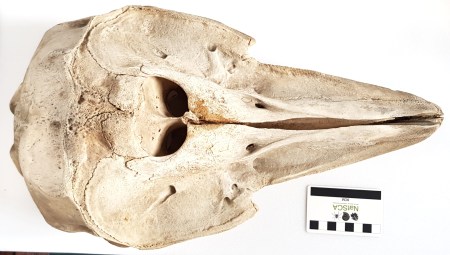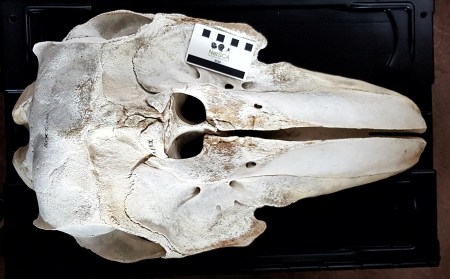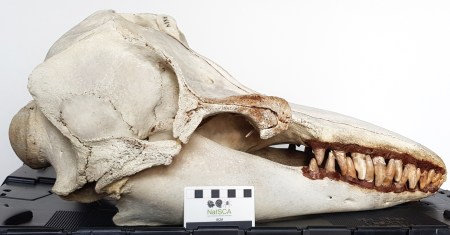This week I have couple of specimens for you to have a go at identifying:
I think these have been mislabelled and need their identifications checked to see if it’s a simple label swap or if it’s a deeper problem with the documentation. I won’t make it easier by providing the labels I’m suspect about – let’s see what you think working just from these images…
Have fun!





Despite extensive visits by the tooth fairy, the one on top still looks as though it ought to have a spongy melon on the top right bit, that helps channel sound.
Will need to check a previous post of yours to remember exactly what the scale on that NatSCA card is.
But the one at the bottom looks similar, except for larger teeth and a smaller melon. Which would suggest larger eyes and more hunting by light.
Both, of course, while related to each other (this is my guess) are also distantly related to the hippopotamus and the pigs, but are both almost exclusively carnivorous I’d suggest.
As to species-level identification, I shall wait until wiser heads than mine get involved. (Also do a little sneaky research on google images etc.)
I think Ric’s idea of a “killer” answer for the lower skull might be a good one, albeit maybe the “pseudo-” version thereof?
I agree with you. It is not Willy, this guy is rather wearing a black suit. Apparently the difference is in the premaxillaries.
Of course! I didn’t want to sound superiorly intelligent and knowledgeable and mention the pre-maxillaries, but now you’ve mentioned them, I have to throw away my glasses, pull my cape out of my trousers and announce myself as Supertaxonomist.
More seriously (though I might try to guess from the name): what are pre-maxillarias?
You’re right, sorry for the jargon. Pre-maxilla is usually the bone where are the upper incisors. But in whales the skull anatomy is different and the pre-maxilla are above the maxilla with the teeth. On picture 3 that is the two long plates on both side of the central longitudinal “gap”.
No no, don’t apologise. I love the jargon. I just don’t know it, so love the explanations too. I could’ve googled it and not sounded like such a div, but this explanation is so much better. Ta.
Well… good observations by Mr Palfreyman earlier; they’re both cetaceans of course, medium sized, the top a little smaller than the lower. The lower skull is easier to make a casual guess at – the teeth draw me to suggest the largest dolphin species, a black and white mammal known for its co-operative hunting tactics and woefully short life in captivity. So as to the first, Mr Palfreyman has observed the teeth alveoli, unfortunately all teeth are missing, but from the alveoli shape I would deduce these are smaller, peg like teeth than the ferocious predator below. So if the lower is a pied dolphin on steroids with an attitude problem then may it be the upper skull is possibly the largest Phocoenid rather than a Delphinid? There’s something about the concave appearance of the temporal bone area that suggests that hunch, though it’s hard to put into words. Looking at the specific name of my most plausible suggestion for the upper skull – might it have a casual association with a well known Spanish surrealist artist?
Now that I have consulted my copy of Lyall Watson’s “Whales of the World” I can eliminate the suggestion I made for the first skull.
I was first looking at Delphinidae because I was not convinced by the presence of a bony “bump” before the naris holes in skull 1, but now I fallow you on Phocoenid. But instead of the Spanish artist I would suggest another species, its name sounds like an echo.
So, these 2 guys have teeth and an asymmetric skulls. So that they are toothed whales (Odontoceti). But there are many genera and species. The size range is closer to dolphins than large whales. Both are very short snouted. The second guy is not a “dolphin” because of the strong teeth and low number of teeth. For the moment I’m stuck in Delphinidae, I have to search in more details later.
I give up for the first skull. I’ve an old identification guide of the FAO but these dolphin guys are really too tricky for me
https://polldaddy.com/js/rating/rating.jsThe dolphin family — Delphinidae — have quite a range of tooth sizes and tooth number. The big black-and-white guy (who had the genus name Grampus when I was young, though that seems to have fallen out of fashion) has, not surprisingly, the biggest teeth, so I’m sympathetic to the suggestions that the bottom skull being his species. But with the number of species in the family, I’m not at all confident.
https://polldaddy.com/js/rating/rating.jsUmm… Teeth of modern cetaceans (those that have teeth) are… single-rooted, aren’t they? So, counting alveoli in an edentulous(*) skull gives you the number of teeth it used to have. Sort of hard to do with the photo we have of the top skull, but … mid to high 20s?
W.r.t. suggestion that it might be a “Puffing Pig” (Phocoena), a photo on the WWW of a skull of the most common species of THAT genus seemed to have an upper tooth row of 29. But they are small teeth, and to my (unpractised) eye looked a bit more closely spaced than the alveoli on the picture here.
https://polldaddy.com/js/rating/rating.js(*) Oh. Forgot to add. Like Palfreyman, I love the big words anatomists and zoologists use. Anatomy and zoology are old enough sciences that they were established by people who had been taught Latin in school: you never get words like that in, say, Computer Science! Isn’t “edentulous” a lovely word?
” Isn’t “edentulous” a lovely word?”
Yes it is. Though I had to look it up to ensure my interpretation was correct.
There is, of course, a modern social history of humanity to be discerned in all of this.
As far as I am aware, Latin was the language of scholarship through the “Dark Ages” and “Middle Ages” as a result of the church’s having adopted it (Rome, Pope and the Vulgate, etc) and also being in charge of education and, therefore, the very idea of scholarship.
When Copernicus, Galileo, Newton et al came along, it was accepted that a “scholar” used Latin, however he (they were always “he” weren’t they?) spoke in the demotic – English, French, Spanish, Italian, German and so on.
Thus the very idea of science as a co-operative enterprise across various intellects (Newton being an early, cantakerous, jealous, screwed-up-in-the-head exception) was underpinned by the scientists; sharing of information through the language of scholarship. And then Karl Linne decided to Latinise his name and his system of taxonomy.
And many decades (even a century or a half?) later, when informal had to be formalised, Latin, or Latinate forms, were convenient to use because they did not privilege any of the demotic tongues being used. Thus whether in the European wars the Prussians, the Dutch, the Iberians, the Romans or the English had some form of dominance mattered not – their language would not prevail over science, which all could share as a second language.
Until the last century and this, when we’ve discovered that some of the most fascinating palæontological specimens to be currently found are in China, and therefore the Chinese scholars are creating species names (and important ones) using Wade-Giles, or more importantly, Pinyin, to romanise sounds that do not exist in the Latin tongue.
In short, all the major European languages have a relationship (of descent in the case of Spanish, French and Italian; of being an in-law in the case of English, or being a cousin in the case of German) to the Latin that their scholars were using. So the language did not discriminate against any of them too much. But Chinese not only bears no such relationship to Latin, but isn’t even part of that language family (even in India the north Indian, Sanskrit-derived, languages can claim some kinship to the common language of taxonomy, by being part of the Indo-European language group).
To that extent, taxonomists outside Europe are doubly handicapped – the script used is not theirs, and the linguistic conventions used are entirely bereft of relationship to theirs.
A language that started out being adopted as a means of being fair to all (or at least not too unfair to any), has now, because we’ve discovered the world is not the same as Europe, is now a source of particular privilege to those in Europe.
As one brought up in English, and with reasonably wide reading, I find it fascinating to try to guess the underlying reasons, etymologically speaking, for various generic and species names being chosen. But I recognise that English is used as a first language by fewer than a tenth of the world’s population.
And for the remaining 90% I wonder, as Gray once did:
Full many a gem of purest ray serene,
The dark unfathom’d caves of ocean bear:
Full many a flow’r is born to blush unseen,
And waste its sweetness on the desert air.
Some village-Hampden, that with dauntless breast
The little tyrant of his fields withstood;
Some mute inglorious Milton here may rest,
Some Cromwell guiltless of his country’s blood.
Wow, Palfreyman. I have been wasting my sweetness on the desert by trying to Latinize my name. Couldn’t get the project out of my head. Gave up. I have been bemused, as well, by the mis-marriage of Latin-Greek in many species names among birds. I’ve decided that Gray notwithstanding, nothing’s wasted, not even time. As to our mystery, well it has a porpoise beyond my talents.
Magnificent bit of etymological exposition Ravi!
Well, my taxonomic skills are more than a bit hit-or-miss, so I thought I might as well try to prove that my English Literature degree was good for something!
https://polldaddy.com/js/rating/rating.js
https://polldaddy.com/js/rating/rating.jsUmm… Re: Phocoenoides (Ric were you suggesting changing an L to an I to get the name of the Spanish artist): Skuls Unlimited’s replica is like the to pone in having a “chin” that projects beyond the end of the upper jaw, but seems to have over 30 teeth in its left upper jaw. So: could be, but I’m not convinced yet.